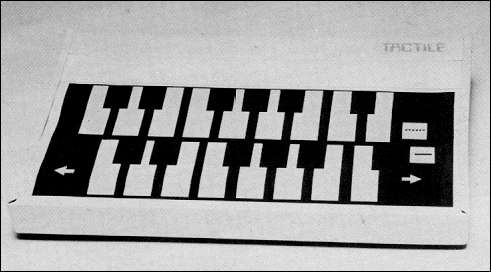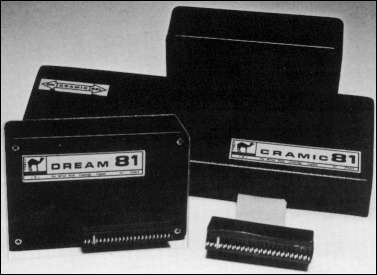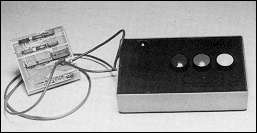| Hardware World |
A VERY USEFUL device for young children is a Tactile keyboard which fits over the Spectrum keyboard. A plastic cover with a flexible top, the Tactile keyboard allows you to design a layout to fit a program.

Being a flat sheet, pictures or numbers can be placed over certain sections of the keyboard, so that children can be asked to "press the PEAR" and the like. The keys pressed can then be checked to see if the correct response has been given.
A piano keyboard is supplied already fixed to the keyboard and children find it fascinating as well as educational.
Programming tips are included so that a range of keys may be checked using Basic or machine code. Designs are made easier by the fact that a clear film can be used with overhead projector pens to trace pictures of objects direct from books and magazines. Early Learning Opportunities is producing software using the keyboard and a tape with a piano and a typewriter program is available from Tactile at £92.95. It is an important device for teaching children to use a computer. The keyboard costs £99.95 from Tactile, Bristol.
* See also Prices update in Hardware World, September 1983.
good Electronics drawing program for the 48K Spectrum.(sic) It contains all the symbols to allow you to design a digital or analogue circuit and COPY it on the printer. There are 62 symbols and each covers the area of one print square.
The program or circuit on its own may be SAVEd to tape to allow you to resume at any time where you left off. An interesting feature is that the program can activate the circuit. That checks and indicates the path of the 0V and the power supply round the circuit. It does not give voltages but checks for continuity, using the symbols as gates through which the current will or will not flow.
The supply current flow is shown in red and the 0V connections in green PRINT squares.
It is very slow - five to 10 minutes - but it can give a good indication if you have omitted some part. All the character set is re-programmed so if you BREAK the program you might find the listing a little difficult to follow.
It is a very useful program which could be enhanced with machine code to improve its abilities.
Electronics is the name of the program and the Spectre agent is at Basingstoke, Hampshire. The Spectre head office is in Hong Kong.
Electronics will be sent anywhere in the world airmail at a cost of £6.95 and includes a money-back guarantee and technical advice.
JILES ELECTRONICS has produced a tape copier which allows you to make back-up copies of software. It does not require a computer to use it but allows the computer to check what is happening by LOADing the program at the time it is being recorded.
The device consists of a black plastic box with three sockets containing an amplifier and a battery.
The input socket is connected to the car socket of the tape recorder and the output socket to the MIC of the second tape recorder. The LOAD socket is connected to the computer if required.
The volume is set at half on the tape recorder with the program in it and normal on the recorder. The recording process is then started with the computer monitoring the signal.
The tapes tested on the Spectrum and ZX-81 versions worked very well. Advice is given on how to align your tape recorder head and there are helpful hints if it does not work. The device is called the CO-DER and costs £99.95 from Jiles Electronics, Derby.
* See also Prices update in Hardware World, September 1983.

THE CAMEL range by Cambridge Microelectronics has been expanded by three new ROM-type packs for the ZX-81. ROM-81 allows you to plug-in up to 8K of EPROMs into the two sockets provided - 2716 or 2732 types.
The memory area covered is selected by soldered straps inside the black plastic box.
The Dream 81 has 64K of RAM plus an EPROM socket which will take up to 16K of EPROM - 27128. The EPROM replaces the RAM between 8K and 16K on the memory map and permits the use of the slower 450ns EPROMs.
The 16K of the 27128 is split into two 8K areas switched in and out by a switch inside the pack, which makes it a little awkward as it is under the cover and not removable when using the machine.
The Cramic is a bigger version of the Memic (16K) which resides in parallel with the 16K RAM on a ZX-81. It can be used to capture and retain any 16K program. Used in conjunction with a 16K RAM pack it allows you to restore a program in seconds. The Cramic is bank-switched by a software I/O output instruction to ports 16 to 31.
The control of switching and copying of memory to the Cramic is done by a small machine code program in a REM statement at the beginning of each program and must be typed-in or run in from TAPE before using the pack.
The Passport program allows you to use the Cramic as a second program, switching between that and the original. Spare memory in another location will be required to swap variables between programs. The Cramic is housed in an 8¾in.x1in.x3in. black box which is attached to the ZX-81 by a flexible ribbon cable. An expansion connector is also provided at the back for the RAM pack.
The RAM consists of 6116-type memories backed up by a lithium battery. The cover has two switches; SEL brings in the Cramic during a program and ON allows the Cramic to be put in parallel with the existing 16K RAM so that any program typed-in may be 'captured' by just deselecting the Cramic. Unfortunately that crashes the program in RAM but re-inserting the machine code will bring it back as good as new.
The Cramic costs £91.95, ROM-81 £17.20 and the Dream-81 £80.45 from Cambridge Microelectronics Ltd, Cambridge.
HILDERBAY has produced for the Spectrum a printer interface as well as software to run it, including a mini word processor. The black box has a 23-way printer plug on the front and a ribbon cable of up to one metre ending in the usual Centronics-style plug. The box has no extender PCB, so any add-ons such as Microdrives must go between that and the printer interface.
The software is a Basic program and a small piece of machine code. The Basic program allows you to set up a series of options which are then incorporated into the machine code.
TASWORD can have the printer software inserted so that it uses another printer instead of the ZX printer.
The options on most printers are different but they can offer underline, emboldened or enlarged text using the graphics characters re-programmed to give control characters.
A COPY software routine is also included but not using the COPY command. All other commands are by the use of LLIST or LPRINT. There should be no need to go inside the printer to set up the CR/LF options as they can be set from the software.
It is a very good combination of hardware and software at £45. Hilderbay Ltd, London.
COMPUSOUND, which produces the audio modulator for the ZX-81, Spectrum and other computers is taking action against Kayde for allegedly copying its Telesound 84 which has a patent pending. The Kayde module first appeared at the Midlands Computer Show in April.
MAPLINS has two kits of interest to the ZX-81 user and both can be used to provide an online 300-baud modem. The first, which is the modem, was issued as a kit in February, but until now the RS232 and the software was not available to use it.
The important thing about 300-baud working against Prestel is that it is used commercially to obtain information from databases for which you have to pay a fee and also you can communicate with other computer users who do not have ZX-81s. Free databases or bulletin boards are also available; a list of them can be obtained from the Association of Computer Clubs.
The modem is not the easiest of kits to build as it uses a five-band resistor colour code but if you follow the instructions to the letter the kit can be assembled without too much difficulty. The problem is in setting-up the modem and connecting it to a telephone line.
To set up the modem an oscilloscope is essential, except that it is difficult to set up accurately. Most of the controls can be set up using a sensitive voltmeter but to check the mark space ratio the modem is best looped back to itself and, using the RS232, sending Us until Us return on the screen.
Having set up the modem, a plug and socket must be ordered from British Telecom to connect it to the line. Once connected to the telephone line, you can telephone Maplins and order components, cheek your item is in stock and if you are using a credit card, pay for it.
The RS232 kit is much easier to build but you will require a motherboard and at least 2K of RAM to run the terminal program - the program to talk to the modem. The software is stored on tape and conversion is made to ASCII characters by using an EPROM. The RS232 can also be used to run a printer or to talk to another computer which has an RS232.
The RS232 interface cannot produce negative voltages, so full implementation of the standard is not possible.
The modem costs £40.45, RS232 interface kit £25.45, motherboard £8.45, modem case £7.85. Maplins is at Rayleigh, Essex.

ELECTROTECH has produced a large box containing a programmable joystick and three large push-buttons. In appearance it looks very similar to the large games machine controls. A printed circuit board which contains a 2K RAM plugs into the back of the Spectrum. It is used to store the information on what keys to operate when the joystick switches are operated.
There are eight positions on the joystick as the corners also operate both switches. Whether that will be useful or confusing will depend on the game. All the microswitches are large professional types which should last a long time. That also explains the cost of the joystick, expensive at £43.70 for the standard model.
A tape which accompanies the joystick is a Basic program which allows you to program the joystick and SAVE the results on to tapes as a machine code file.
It allows you to reload the key combinations for a game without the slow process of the Basic program.
The keyboard is not affected and can be used as well as the joystick for entering the score. Seven functions can be programmed - three switches and a four position joystick.
The cost might suit some shops which wear out joysticks very quickly but there seem to be cheaper alternatives for the average user.
THE PRINT'n'Plotter console is a cardboard stand for the Spectrum, printer and power supply. The console arrives packed flat and can be constructed easily into a solid, vinyl-covered box in about half an hour. The instructions are clear and simple and there is an alternative of housing four tapes instead of the printer. Cutouts are provided at the back for tape and TV power supply and a ventilation slot under the Spectrum heatsink. It is necessary to tidy-up with a black felt-tip pen on the corners where the vinyl has been cut. Those edges could also be covered with adhesive tape to prevent them wearing.
The only disadvantage seems to be that no peripherals will fit directly into the Spectrum except the printer because of the ¾in. distance between the computer and edge of the console. Modifications, however, can be made with a sharp knife.
It is an inexpensive box into which you can put your Spectrum; it tilts it to the correct angle for typing and allows the power pack to be stored inside. By raising the height a slim tape recorder can also be put inside the box.
Print'n'Plotter consoles cost £8.25 from Print'n'Plotter Products, London SE1.
KEMPSTON Microelectronics has produced a conversion tape for six of the most popular games which allows you to convert the game for use with its joysticks. It has also included a machine code version of COPY in the latest release of software for the printer interface, called by a USR command.